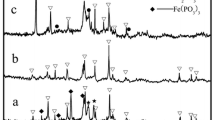Abstract
Olivine LiFePO4, as a cathode material for lithium ion batteries, was prepared by a novel optimized hydrothermal method; afterwards, the product mixed with glucose was two-step (350°C and 700°C) calcinated under high-purity N2 atmosphere to obtain the LiFePO4/C composite. The study on the hydrothermal preparation method, which focused on the influences of molar ratios, initial pH value, reaction temperature, and duration, was made to promote the resultant performances and to investigate the relations between the performances and the reaction conditions. The resultant samples were characterized by X-ray diffraction (XRD), scanning electron microscopy (SEM), and electrochemical tests, which include charge-discharge, electrochemical impedance spectroscopy, and cyclic voltammetry. The result shows that the optimal hydrothermal condition is to set the Li:Fe:P molar ratio at 3:1:1 and the reaction temperature at 180°C for 5 h duration with an initial pH value of 7. The optimized sample, with an average particle size of 100 to 300 nm and a discharge capacity of 118.2 mAh·g−1 at 0.1C, exhibits a stable and narrow-gapped charge-discharge platform and small capacity losses after cycles.
Similar content being viewed by others
References
Fergus J.W., Recent developments in cathode materials for lithium ion batteries, J. Power Sources, 2010, 195(4): 939.
Franger S., Le Cras F., Bourbon C., and Rouault H., Comparison between different LiFePO4 synthesis routes and their influence on its physico-chemical properties, J. Power Sources, 2003, 119–121(2 Spec. Iss.): 252.
Ritchie A. and Howard W., Recent developments and likely advances in lithium-ion batteries, J. Power Sources, 2006, 162(2): 809.
Chen J.J. and Whittingham M.S., Hydrothermal synthesis of lithium iron phosphate, Electrochem. Commun., 2006, 8(5): 855.
Ouyang C.Y., Shi S.Q., Wang Z.X., Huang X.J., and Chen L.Q., First-principles study of Li ion diffusion in LiFePO4, Phys. Rev B, 2004, 69(10): Art. No. 104303.
Franger S., Le Cras F., Bourbon C., and Rouault H., LiFePO4 synthesis routes for enhanced electrochemical performance, Electrochem. Solid State Lett., 2002, 5(10): A231.
Laffont L., Delacourt C., Gibot P., Wu M., Kooyman P., Masquelier C., and Tarascon J., Study of the LiFePO4/FePO4 two-phase system by high-resolution electron energy loss spectroscopy, Chem. Mater., 2006, 18(23): 5520.
Yamada A., Chung S.C., and Hinokuma K., Optimized LiFePO4 for lithium battery cathodes, J. Electrochem. Soc., 2001, 148(3): A224.
Guy D., Lestriez B., Bouchet R., Gaudefroy V., and Guyomard D., Novel architecture of composite electrode for optimization of lithium battery performance, J. Power Sources, 2006, 157(1): 438.
Padhi A.K., Nanjundswamy K.S., and Goodenough J.B., Phospho-olivines as positive-electrode materials for rechargeable lithium batteries, J. Electrochem. Soc., 1997, 144(4): 1188.
Andersson A.S., Kalska B., Häggström L., and Thomas J.O., Lithium extraction/insertion in LiFePO4: an X-ray diffraction and Mössbauer spectroscopy study, Solid State Ionics, 2000, 130(1–2): 41.
Yang S., Zavalij P.Y., and Whittingham M.S., Hydrothermal synthesis of lithium iron phosphate cathodes, Electrochem. Commun., 2001, 3(9): 505.
Wang Z., Su S., Yu C., Chen Y., and Xia D., Synthesises, characterizations and electrochemical properties of spherical-like LiFePO4 by hydrothermal method, J. Power Sources, 2008, 184(2): 633.
Author information
Authors and Affiliations
Corresponding author
Rights and permissions
About this article
Cite this article
Gao, G., Liu, A., Hu, Z. et al. Synthesis of LiFePO4/C as cathode material by a novel optimized hydrothermal method. Rare Metals 30, 433–438 (2011). https://doi.org/10.1007/s12598-011-0409-z
Received:
Revised:
Accepted:
Published:
Issue Date:
DOI: https://doi.org/10.1007/s12598-011-0409-z




